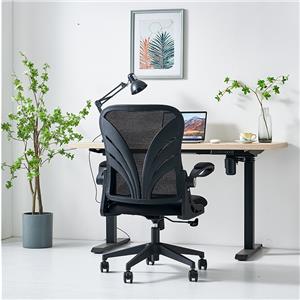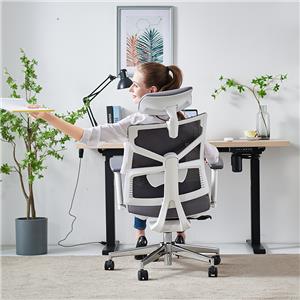Ergonomic analysis in office chair design
Office chairs are humanized in design, starting from ergonomics and using the "people-oriented" design concept to design office chairs that conform to the human body.
With the development of science and technology and the advancement of the times, more and more workers are working indoors and using their brains, and more and more people are working in a sitting posture. The sitting posture will also become the main posture used in future development. If the design of the staff's seats is unreasonable, without considering and designing according to ergonomic principles, and the staff sit in a sitting position for a long time, it is easy to cause certain harm to the human body in the long run, such as the cervical spine. , lumbar, spine and other parts of the disease, have an impact on the health level of staff, and may also have a certain impact on work. Therefore, it is particularly important whether the design of office chairs is scientific.
1. Office chair design purpose and structural analysis:
1.1 Design purpose.
Office chairs have become a necessary piece of office furniture in contemporary daily office environments, and a good office chair design must provide a certain level of comfort to reduce staff fatigue. Domestic design and research on office seats does not pay more attention to comfort, resulting in no better breakthrough and solution to the seat comfort problem. The design of office seats should follow the principles of ergonomics and be put into actual design and production. The design should be based on the actual use value of the seat. The design structure must be reasonable. There is no need to overdo the improvement of the appearance of the seat. The sense of form and rational design present the seat structure so that the seat can truly adapt to the physiological characteristics of the human body. The seat design should be based on the principles of ergonomics and human body measurements, with humanization as the focus. It is best to go through a series of market surveys and analyses, and design a seat that can meet the differentiated back curves of different users. According to the demand, the staff will not damage human health even if they are sitting for a long time, so that the staff can engage in and complete various tasks more conveniently and quickly.
1.2 Structural analysis.
Generally speaking, office seats are roughly divided into: executive chairs, mid-level chairs and employee seats. But the basic main components of office chairs are: bracket, seat surface, cushion, backrest, armrests, and casters.
2. Ergonomic analysis of office chair design:
2.1 Seat height.
The vertical distance from the center of the front edge of the seat to the ground is called the seat height. Seat height is one of the main factors that affects the comfort of the sitting posture. Unreasonable seat height will affect people's sitting posture, and the waist will easily feel fatigued, and lumbar disc will easily develop over a long period of time. If the seat surface is too high and the legs are suspended in the air and cannot touch the ground, the blood vessels in the thighs will be compressed and the blood circulation will be affected; if the seat surface is too low, the knee joints will rise upward. When arched, body pressure will be concentrated on the upper body of the human body. The reasonable seat height, according to ergonomic principles, should be: seat height = calf + foot height + shoe thickness - appropriate space, the approximate range is 38 cm-48 cm.
2.2 Seat surface design.
When the worker is in a sitting position, the two ischial tuberosities under the human pelvis are close to the level. If the sitting surface angle is unreasonably designed to form a bucket shape, the femur will rotate upward, and the hip muscles may feel compressed, making the body feel uncomfortable. Comfortable. The width of the seat surface is set based on the human hip size plus the appropriate range of motion, so the seat surface should be designed as wide as possible to meet the needs of individual tall workers.
2.3 Seat depth.
The distance from the front edge to the rear edge of the seat becomes the seat depth. The depth of the seat is related to whether the human back can lean against the seat back. If the seat is too deep, the supporting points of the human back will be suspended, causing numbness in the lower legs. If the seat is too shallow, the front of the thighs will be suspended and all the weight will be lost. If it accumulates in the calves, the body's fatigue will accelerate. According to ergonomic research, seat depth = seat depth - 6 cm (gap).
2.4 Handrail design.
Designing armrests can reduce the burden on the arms so that the upper limb muscles can rest better. When the human body stands up or changes posture, it can support the body and help the body maintain balance. However, the height of the armrests must be designed reasonably. If the armrests are too high or too low, it will cause Arm fatigue. According to ergonomic research, the height of the armrests is related to the distance from the seat surface. Controlling the distance within 20 cm-25 cm is more suitable for most workers. The angle of the front side of the armrest also changes as the seat angle and backrest angle change.
2.5 Shoulder support design.
The position of the shoulder rest is approximately at the height of the fifth and sixth thoracic vertebrae, which is roughly consistent with the height of the scapula. The bearing area of the scapula is relatively large. The design of the shoulder rest can alleviate the discomfort in the shoulders and necks of staff who have been sitting for long periods of time. This discomfort allows the body to better relax and relieve itself, allowing it to better complete its work.
3. Summary:
The ideal office chair should be based on human body measurements and designed in strict accordance with ergonomics, so that employees will not feel physically and mentally exhausted during long-term and large-scale work, reduce the diseases caused by uncomfortable sitting postures to the human body, and make the work more comfortable. Completed more quickly and efficiently.




